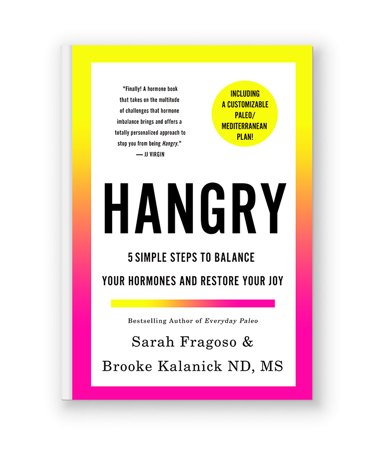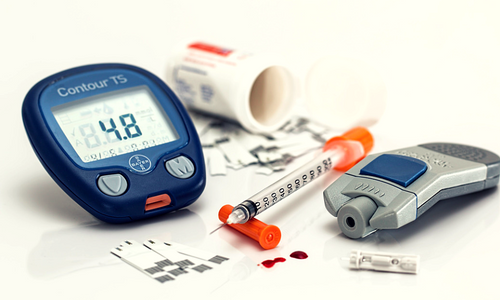
Testing your blood sugar at home is a completely underutilized tool for customizing your diet.
The meter will set you back a few bucks and it’s not totally painless, but after taking it for just a few days you’ll have a whole new understanding of one of your main metabolic hormones: insulin.
Insulin is hardly the only player in your metabolism but it influences most hormones and is one you can exercise a lot of control over, so it’s an important one for you to understand.
While I encourage everyone to use my ACES tool – tuning into the biofeedback cues of appetite, cravings, energy and sleep quality – sometimes you need more concrete info. For some women who have a damaged metabolism from years of dieting or hormonal stress it can be hard to trust these symptoms or cues to gauge your response to your current nutrition plan. And still others of you are following a great plan and feel pretty good but your metabolism is still suffering beneath the surface.
For both of these groups – and for those of you that respond well to numbers – this is a great tool.
Click here for a rundown of home glucose monitors by Consumer Reports. I personally recommend the One Touch Ultra or Relion most frequently.
Note to my PCOS readers: if you have PCOS as a diagnosis a meter will likely be covered by your insurance.
Price point on the glucometer isn’t so bad, the strips are where they get you. However, you won’t be doing this forever so one vial of strips will more than get you started. I do also recommend getting the pen vs. lancets if you have trouble sticking your self. I most often recommend this one.
Get you FREE copy of my Guide To Lab Testing & Your Hormones
This guide covers hormonal testing and thyroid patterns and will show you how to suss out the Hormonal Dealbreakers of inflammation, anemia and blood sugar problems.
Get Your Free Lab Guide HereHow To Take Your Blood Sugar Readings
Poke your finger off to the side not right over your finger pad or print. About half way between the outer edge of your fingernail and the center of your finger print. Also, use a different finger each time to avoid getting sore. I also find that the ol’ hold your hand down at your side, shake it a bit, make a fist repeatedly really helps get the blood flowing – especially if you are a bit nervous. But don’t be, this only hurts for literally a millisecond and many times you won’t even feel it at all.
If after you stick yourself you’re not getting much blood, simply milk your finger along the side or repeat the above dangle and shake.
More often than not you will get a bit of blood without re-sticking – and with the meters these days, you hardly need any, no more than a drop. And the meter will tell you if there’s not enough. + Then simply have the machine ready to go with a strip inserted and then touch the extending strip to the drop of blood and it takes it right up.
The meter does it’s thing and in a matter of seconds you have your reading. For a video demo, see this. Warning: boring, boring video! But it shows you how to use the lancet pen as well as the meter, so if you can bear with it, it’s solid info from the Mayo Clinic.
When To Take Your Readings
When, how often and after what meals you take a reading completely depends on what you’re looking for.
For fat loss and better blood sugar balance, what we’re trying to see is how you respond to different meals and particularly different types and amounts of carbs. Here’s what I suggest:
- Fasting. Take ASAP after waking, before any food, drink or exercise – and before much can happen at all because cortisol will raise your blood sugar. So no stress! It’s great to get a fasting reading to see how you’re waking and then you also have a baseline for the day. Ideal readings here are between 85-95 ng/dL. Above 99 and we are in the pre-diabetic range, above 120 we are in the diabetic range. There is some debate about how low is too low. Conventionally, hypoglycemia is diagnosed at 65 but many struggle with low blood sugar in the 65-80ng/dL range so most functional practitioners use 85-99 as the ideal range. In my practice, I use that range as a baseline, but take your unique low blood sugar symptoms, metabolic issues and results into account.
- At the start of the meal.Note how long it’s been since the start of your last meal. By 3 hours after you should be back below 100 or to your baseline/fasting reading.
- + 1 hour after. The start of your meal, you want to be no higher than 140 ng/dL
- 2 hours after. The start of your meal, you want to be no higher than 120ng/dL
Order Hangry and get some AMAZING bonuses right now!
If you’ve ever felt like a Hangry B*tch and are ready to balance your hormones and restore your joy in just 5 simple steps then Hangry is for you!
GET YOUR BONUSES NOW
Variables to consider changing:
- When you first start looking at blood sugars, I suggest you test it with your current diet.
- If you’re already following a plan but want to dial in how much and what types of carbs you should be eating, then you simply change up the carb type and amount but keep other foods in the meal the same. For example, if you’re testing 50g of carbs from pumpkin vs. 50g of carbs from sweet potato OR 50g carbs from sweet potato vs. 75g carbs from sweet potato you keep the rest of the meal the same i.e. chicken or fish and veggies dressed in same amount of oil/dressing. This helps you really see the carbs effects without wondering if it was fat, fiber or protein type that changed your reading.
- If you’re trying to fine tune carb intake do the experiment I just mentioned with 50g and then 75g of the carb in question and see what happens. If you’re training heavy, you may also want to see if you need more carbs to check your response to up to 100 or 150g carbs post workout as well.
A couple things that can throw off your results
1. Low Carb Diet
If your diet is normally low carb (75g per day or less), you will be more insulin resistant/less efficient at burning carbs and better at burning fat for fuel. So if you are doing a reading after a particularly high carb meal (150g or more) you will see an elevated reading. The main goal with doing this experiment is to test you with your normal diet – whatever that may be – and see your patterns. From here you can change a variable like carb type or amount and see your response.
So while your readings after a higher carb meal may be artificially high – and had you been in a lab, you would’ve been instructed to have a consistently higher carb intake for three days prior to the test – it is you, on your diet and that is useful info for you to utilize to customize your diet.
More on finding your Unique Carb Tolerance here
However, if what you’re seeing per your labwork doesn’t seem to match with your home readings you can consider subtracting 10 from your one and two hour readings after higher carb intakes.
2. Meters Aren’t Perfect
Even good monitors have about a 10% margin of error. You need to take that into account when you interpret your results. A reading of 100 mg/dL could be anything between 90 mg/dL and 110 mg/dL if you had it tested in a lab. Again though, look for the patterns in your current diet and as they change when you tweak the carb type or amount. If you’re worried, take your readings into your practitioner to discuss.
3. Stress
Remember that cortisol and adrenaline also raise your blood sugar. So if your reading seems oddly high for what your normal response is to a particular meal, consider if you had any acute stress prior to taking the reading. If you are under chronic stress and seeing trends of higher and higher readings, then consider that stress may be making you more insulin resistant.
Order Hangry and get some AMAZING bonuses right now!
If you’ve ever felt like a Hangry B*tch and are ready to balance your hormones and restore your joy in just 5 simple steps then Hangry is for you!
GET YOUR BONUSES NOW


